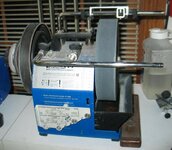I ordered the tormek t 3 sharpening system along with the jigs for sharpening skews and gouges. I've been working on the skews but have a real problem. From free hand sharpening over the years the ends are pretty much a mess. Once in a while I get a good partial edge on something and am good to go.
but now with the tormek it seems that once I set the skew in the jig and line it up to sharpen it is so out of shape that the sharpener only reaches part of the cutting edge. It appears to me the entire blade end will need to be completely reshaped. I was wondering if that is sometihng I should try on the tormek water stone or should I get some more aggressive stone to take metal off or with the attachment that supposedly grades the wheel into a lower grit for more metal removal be used on the wheel. Then take the metal off and then redo teh wheel to back at 1000 grit or were ever it is.
Barring that is there someone out there that is really good at grinding and sharpening tools and could get them in the proper shape so that I could then sharpen them without tearing up my wheel. I would send you a medium flat rate box with about 8 tools in it, oval skews, skew chisels and a couple different gouges. I would pay for shipping to and from. If anyone feels like taking on that task and has the time, what would you charge per tool to do that and then repack them and return them to me?
Just wondering if that is not a better way than me tryinng to do it.
but now with the tormek it seems that once I set the skew in the jig and line it up to sharpen it is so out of shape that the sharpener only reaches part of the cutting edge. It appears to me the entire blade end will need to be completely reshaped. I was wondering if that is sometihng I should try on the tormek water stone or should I get some more aggressive stone to take metal off or with the attachment that supposedly grades the wheel into a lower grit for more metal removal be used on the wheel. Then take the metal off and then redo teh wheel to back at 1000 grit or were ever it is.
Barring that is there someone out there that is really good at grinding and sharpening tools and could get them in the proper shape so that I could then sharpen them without tearing up my wheel. I would send you a medium flat rate box with about 8 tools in it, oval skews, skew chisels and a couple different gouges. I would pay for shipping to and from. If anyone feels like taking on that task and has the time, what would you charge per tool to do that and then repack them and return them to me?
Just wondering if that is not a better way than me tryinng to do it.

